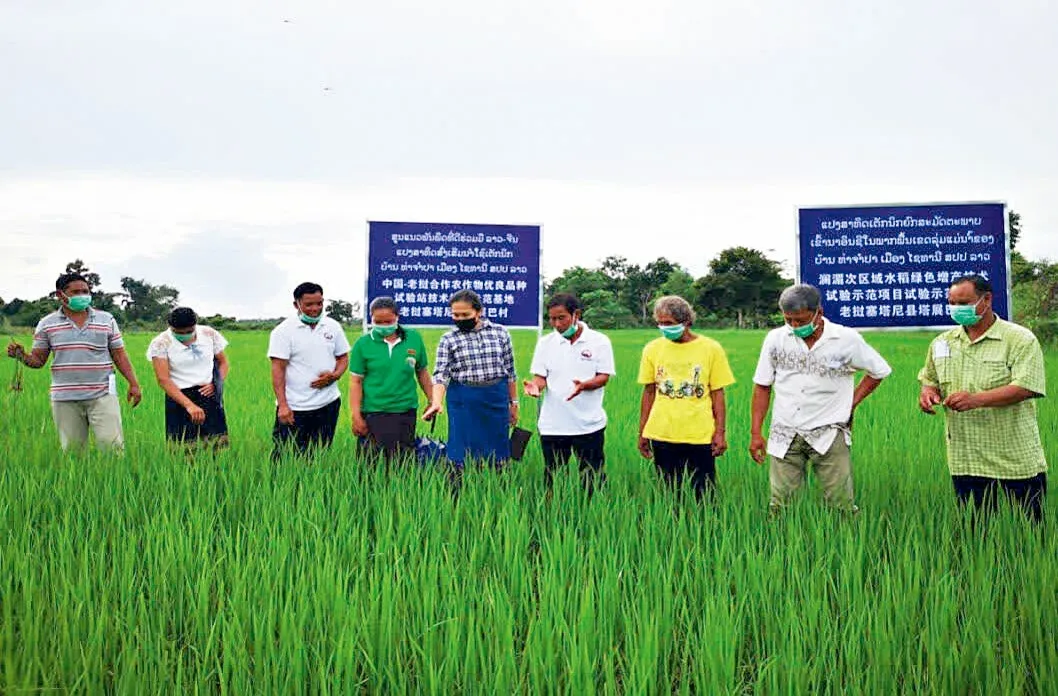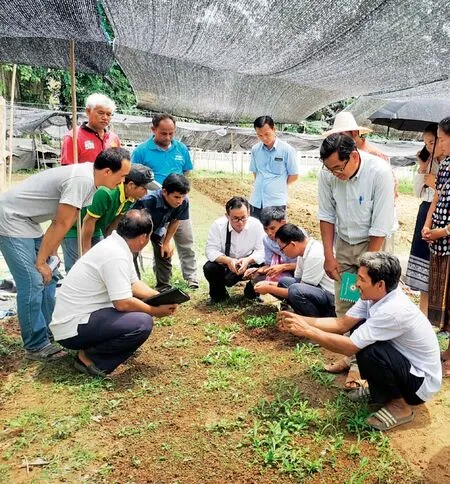China’s Farming Help in Laos
By Huang Jiangqin
China’s farming technology has helped boost agricultural economic development in its southern neighbor
Chen Jiuzhong,a Chinese technician at the China(Guangxi)-Laos Fine Crop Varieties Experimental Station located in Xaythany District,Vientiane,capital of Laos,has stayed firm at his post without returning to his homeland since he was assigned to the station nine years ago.
The Laos station is the first of its kind constructed by China in an ASEAN member state.Since it was established in December 2013,270-plus varieties of crops have been trial planted with 67 of them found suitable for mass cultivation in Laos and more than 1,000 local technicians and farmers receiving professional training.An important platform for exchange of agricultural technology between China and Laos,the experimental station has developed into a modern research base integrating trial planting,new technology promotion,and agriculturerelated training.
More Difficult Than Expected
Over the past nine years,staff of the experimental station encountered enormous difficulties promoting new crop varieties,but managed to overcome.
When Chen Jiuzhong was first sent to Laos after graduating from university and started work in 2013,he encountered more difficulties than expected.“Local agricultural production was solely dependent on natural precipitation for irrigation in the rainy season,” he revealed.“Without any irrigation facilities,their farmland would turn into wasteland during the dry season.” Traditional methods of farming without pesticides or chemical fertilizers were often accompanied by serious plant diseases and pest problems as well as low crop yields.

Local farmers pose for a photo showing a productive corn crop selected by the China (Guangxi)-Laos Fine Crop Varieties Experimental Station.(CHEN JIUZHONG)
“Local farmers lacked solutions to plant diseases and pest problems and some resorted to primitive methods like chili pepper water to only a limited effect,” said Chen’s colleague Lyu Feng,another Chinese technician at the experimental station.
With high temperatures throughout the year and abundant rainfall,Laos has a typical tropical monsoon climate.The country is endowed with ideal weather and a large number of plains and basins suitable for agricultural production,but due to the absence of modern farming systems and a lack of understanding of crop plant genetic resources,the production efficiency of food crops in Laos has long remained low and the quality of cash crops is in great need of improvement.
To help Laos improve agricultural productivity,the experimental station selected 67 crop varieties suitable for local conditions but the farmers were hesitant to change at first.
“We built eight vegetable greenhouses in Ban Tha Dok Kham Village but the villagers were not interested in our structures at all,” Lyu recalled.“They had never seen such a facility before,let alone growing crops in one.”
Noting the villagers’hesitation,leaders of the village led cultivating vegetables in the greenhouse and provided a convincing demonstration.Local farmers eventually realized that compared to their traditional methods,greenhouse farming increased crop yields and helped reduce the cycle of growth from eight to six weeks.The greenhouses in the village were also equipped with a crop management system integrating irrigation and fertilization,which made greenhouse cultivation even more attractive to local villagers.
From Doubt to Acceptance
Every morning,both Chinese and Lao technicians and managers at the experimental station meet to plan their schedule before assigning work to farmers and workers.In the afternoon,Chen Jiuzhong,Lyu Feng,and other technicians would visit the crop fields and give the workers instructions.
The language barrier was another challenge plaguing staff in the early years of the station.Only one translator from the Ministry of Agriculture and Forestry of Laos worked at the station at the time,who could not satisfy the robust needs of the station staff.Thanks to nine years of study in his spare time,Chen,the most senior Chinese technician at the station,now speaks fluent Lao language.“Our work would be more productive if more agricultural technicians have good command of both Chinese and Lao languages,”sighed Lyu,who could hardly understand his local colleagues in his first year.
Their first success arrived in 2014 when the station harvested cantaloupe after three months of trial cultivation.To celebrate,the country’s first cantaloupe festival was held in Vientiane.Local people excitedly poured into the station headquarters to taste the first-ever homegrown cantaloupe they dubbed“Chinese sweet melon.”
The station also heard voices of doubt from locals.“At first,they refused to grow a finer variety of banana we introduced,” remembered Lyu.“When seeing the banana varieties from China produce bigger fruits and higher yields,some people were sure we used chemicals and didn’t even want to taste the fruit.”
To remove doubt about Chinese farming methods,the station carried out multiple exchange activities and invited agricultural officials and experts from local governments to visit the test plots and receive training.“From curiosity and misunderstanding at first to gradual acceptance,local farmers are now eager to study our new cultivation techniques.”
The experimental station has not only helped local farmers improve the production and quality of their crops,but also played an important role in promoting agricultural education in Laos.Besides farmers,other frequent visitors to the station include college students,representatives of agricultural firms,and officials from relevant government departments.

Chinese and Lao agricultural technicians visit a demonstration base for high yield rice breeding in Laos.(LYU FENG)
From Wasteland to Production Base
After the outbreak of COVID-19 in 2020,local workers at the experimental station were sent home as required by the containment policy of the Lao government,and the five Chinese technicians were left with all the work at the station.For a couple of months,the station was operated by only three staff members.In addition to the shortage of manpower,the station’s agricultural production was also affected by rising prices of farming-related products and disrupted logistics between China and Laos.
The station staff managed to carry on despite the mounting challenges.“We worked out solutions to our problems based on local conditions,” Lyu Feng told China Report ASEAN.“When Chinese-produced fertilizers became hard to purchase,we selected and improved farmyard manure used by the local farmers and such strategies turned out effective.”
Since its establishment in 2013,the station has welcomed a number of Lao leaders who warmly applauded the efforts of the staff.“It is gratifying to know our work has been useful in improving the lives of local villagers,” said Chen Jiuzhong.“We built greenhouses in local villages and grew rice,vegetables,and fruits on the formerly wasted land,which set an inspiring example for villagers to follow.They became active in improving their living standards through their own efforts.”

Chinese technicians instruct Lao farmers on greenhouse farming.(CHEN JIUZHONG)
According to Chen,greenhouse cultivation of vegetables introduced by the station delivered tangible benefits to Ban Tha Dok Kham Village.After receiving technical training at the station,the villagers transformed wasteland in their hometown into a vegetable production base that attracted many wholesalers and created jobs.At the same time,due to favorable temperature and sunshine in the greenhouses,the vegetables grow faster,allowing for a shortened production cycle.
The success of the experimental station marked China’s farming technology helping boost the development of the agricultural economy in Laos.Farm produce grown with the help of the station has also been exported to the Chinese market,generating greater profits for Lao farmers.
Chinese Experience
Agricultural technology has always been an important area of cooperation between China and ASEAN countries.Since the two sides established dialogue relations in 1991,more than 200 exchange programs in this field have been carried out and over 40 key projects such as the China-Philippines Agricultural Technology Center,China-Cambodia Modern Agricultural Technology Cooperation Center,and the Chinese Agricultural Demonstration Center for Laos have been implemented.Such projects serve as a platform for joint research,technology demonstration and promotion,and personnel training and provide technical support for the sustainable development of agriculture in ASEAN countries.
Lyu Feng is planning to return to Laos and continue his work at the experimental station to put the long-term plans of the station into operation.“We are seeking cooperation with Chinese-funded companies to foster mass cultivation of our crop varieties and introduce China to the fine crops we have cultivated in Laos,” he said.
China has long been a partner of Laos in agriculture,and the China-Laos Railway is expected to facilitate the transportation of agricultural products and closer cooperation between the two countries.Chen Jiuzhong noted that the cost of cross-border transportation has already been significantly reduced by the rail service.Laos has abundant land resources,suitable climate and low labor costs,so rail access has made it increasingly attractive to Chinese investors and agricultural firms.
Implementation of the Belt and Road Initiative inspired China and Laos to enhance their cooperation on agricultural technology and more Chinese companies to consider Laos an ideal investment destination.Compiled by the Ministry of Agriculture and Rural Affairs of China,the 2021 Report on China’s Agricultural Foreign Investment and Cooperation showed that Chinese direct investment in Laos was concentrated on crop production and mainly targeted at local farmers.
Lyu offered suggestions for Chinese investors interested in Laos.First,in-depth market research is important.Laos has no winter,and vegetables and fruits can grow throughout the year,so it’s more profitable to sell farm produce from Laos to north China in the wintertime.Second,quick business expansion is not recommended.Companies unfamiliar with local natural conditions and plant diseases and pest control in Laos should begin with smallscale cultivation and find the best farming method through trial and error.Third,Chinese firms should understand local agricultural policies and comply with the laws and regulations of Laos.
With COVID-control measures taking effect,the experimental station has now resumed its training sessions and exchange activities.“To better build on China’s experience in agricultural development in Laos,research institutions like our station should seek to work with commercial organizations,”Lyu opined.“Joint efforts by researchers and firms can provide stronger financial,technical,and personnel support to help Lao farmers harvest more fruits.”
- China Report Asean的其它文章
- Cross-border E-commerce Boosts China-ASEAN Agricultural Cooperation
- OVERCOMING THE FOOD CRISIS TOGETHER
- FAO Official Urges Countries Not to Impose Food Export Restrictions
- Unlocking the Potential of China-ASEAN Wind Power Cooperation
- What’s Next For Sri Lanka
- The Block-by-block Revival of an Ancient Chinese Building Technique

